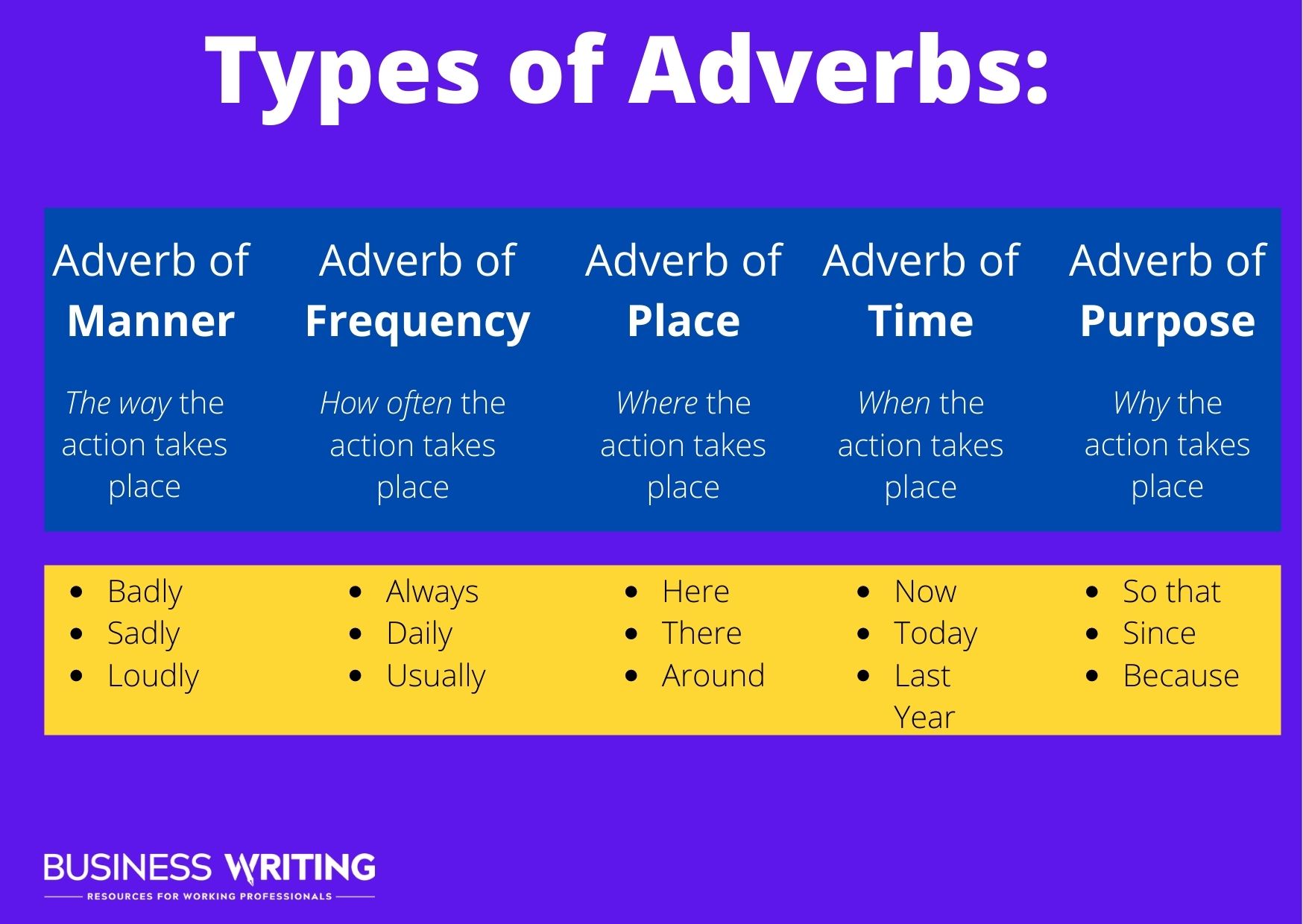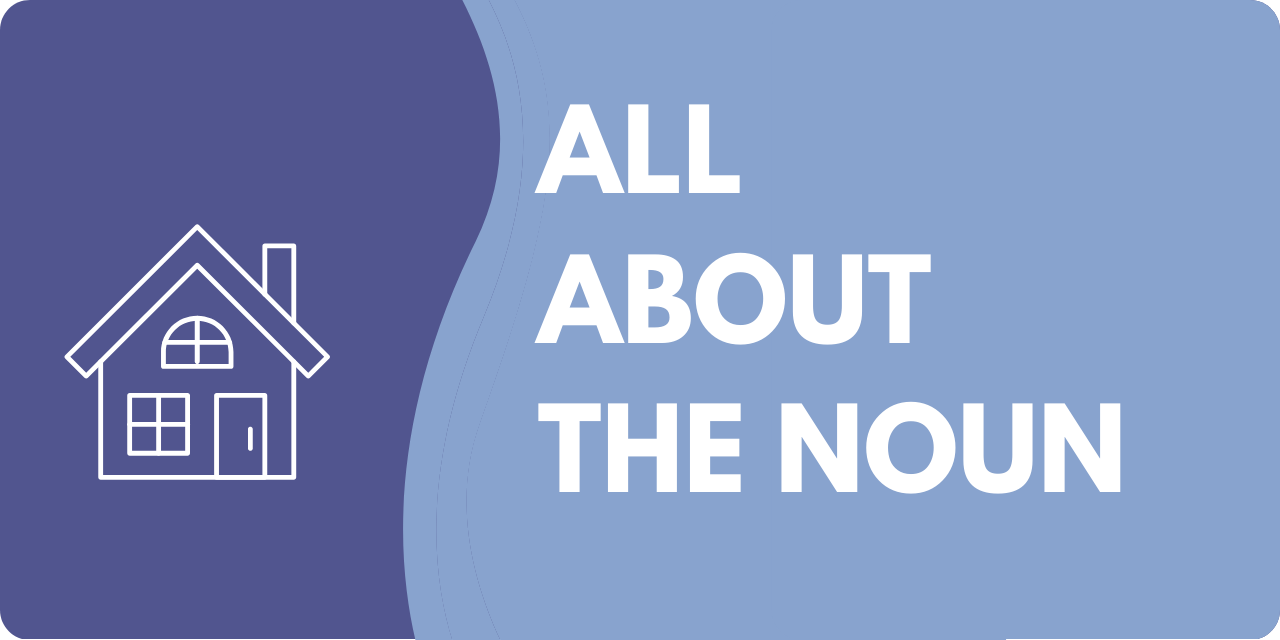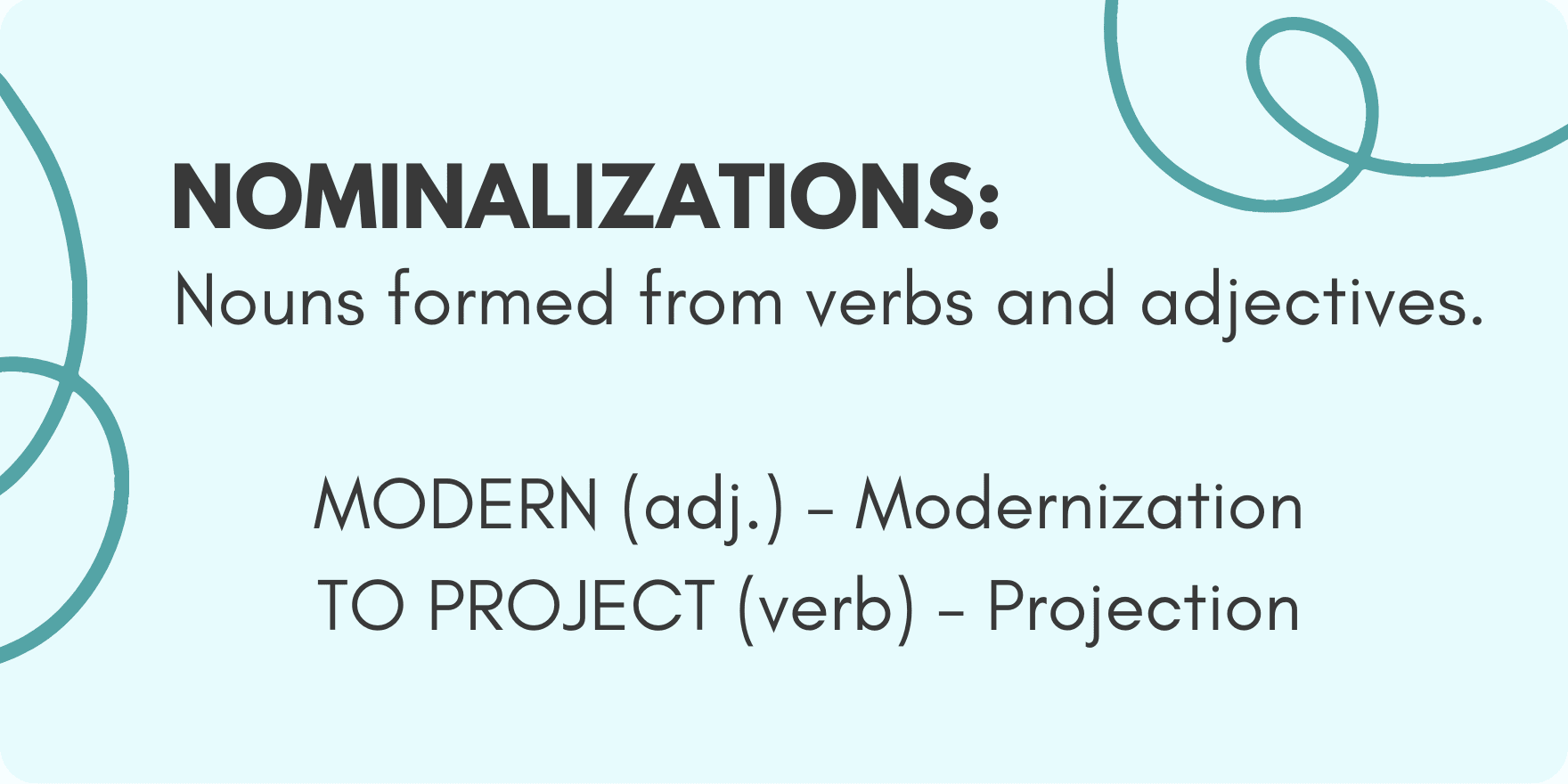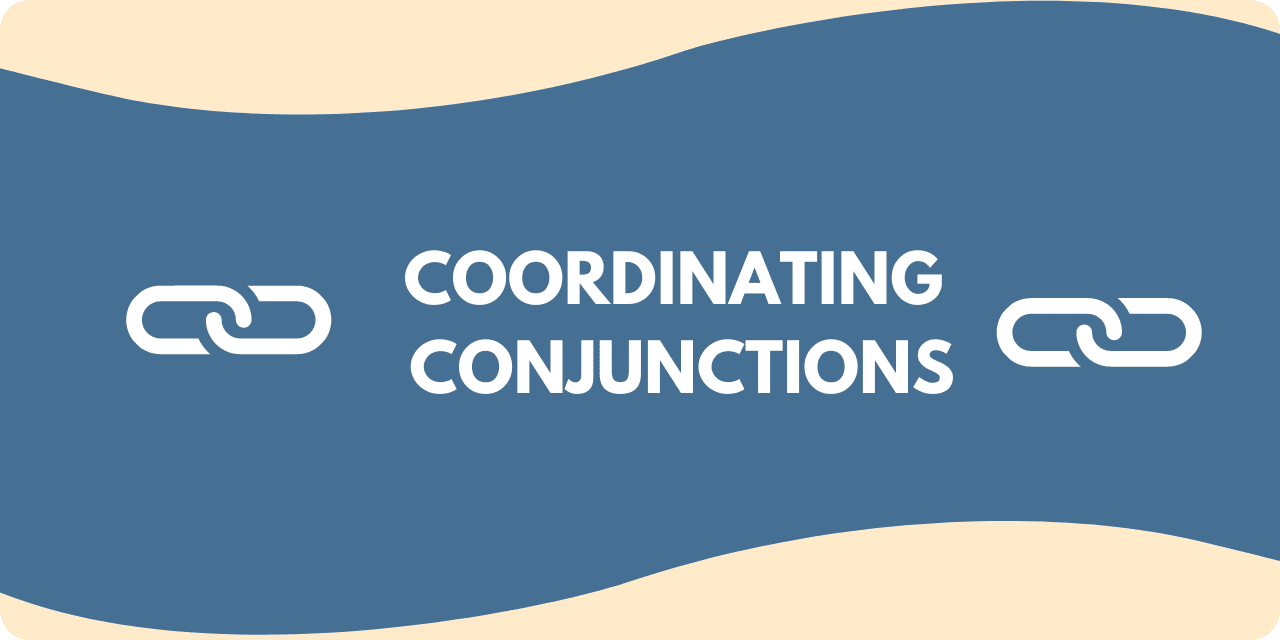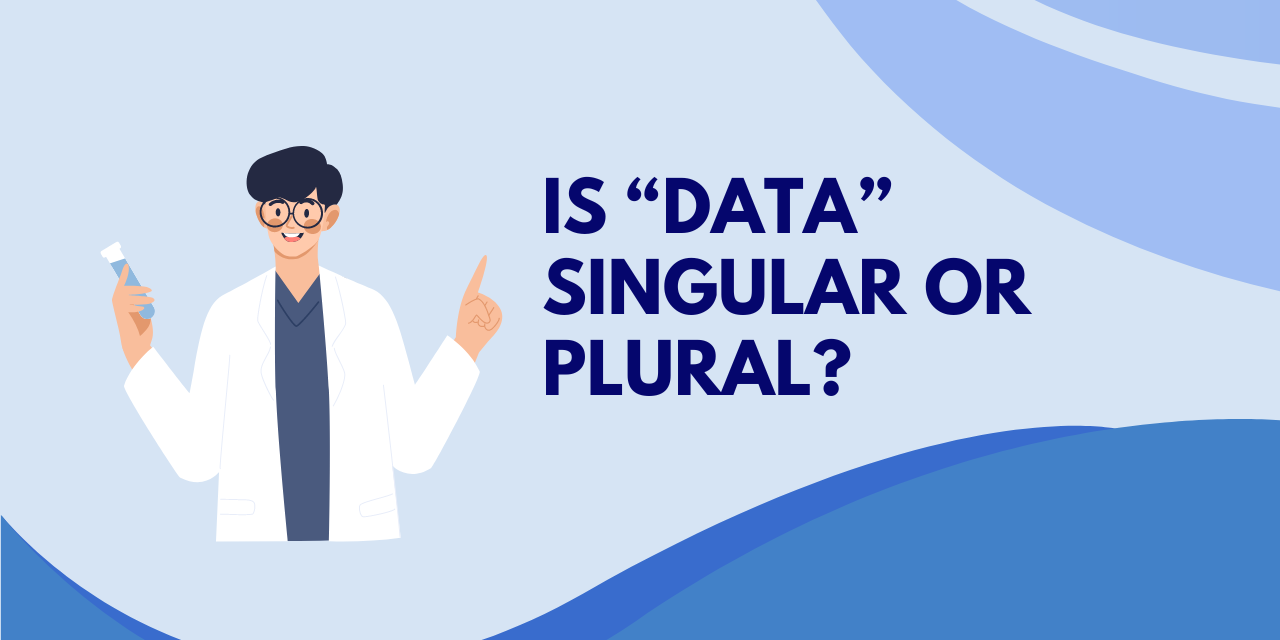What Are Adverbs?
Adverbs are words that describe and/or modify a verb (he talks loudly), an adjective (very small), another adverb (ended too quickly), or even a whole sentence (Fortunately, I had brought an umbrella). Adverbs often end in -ly, but some (like fast) look the same as their adjective counterparts.
Example Tom did not run badly.
Tom is very short.
The race ended too quickly
Fortunately, Arielle recorded Lucy’s win.
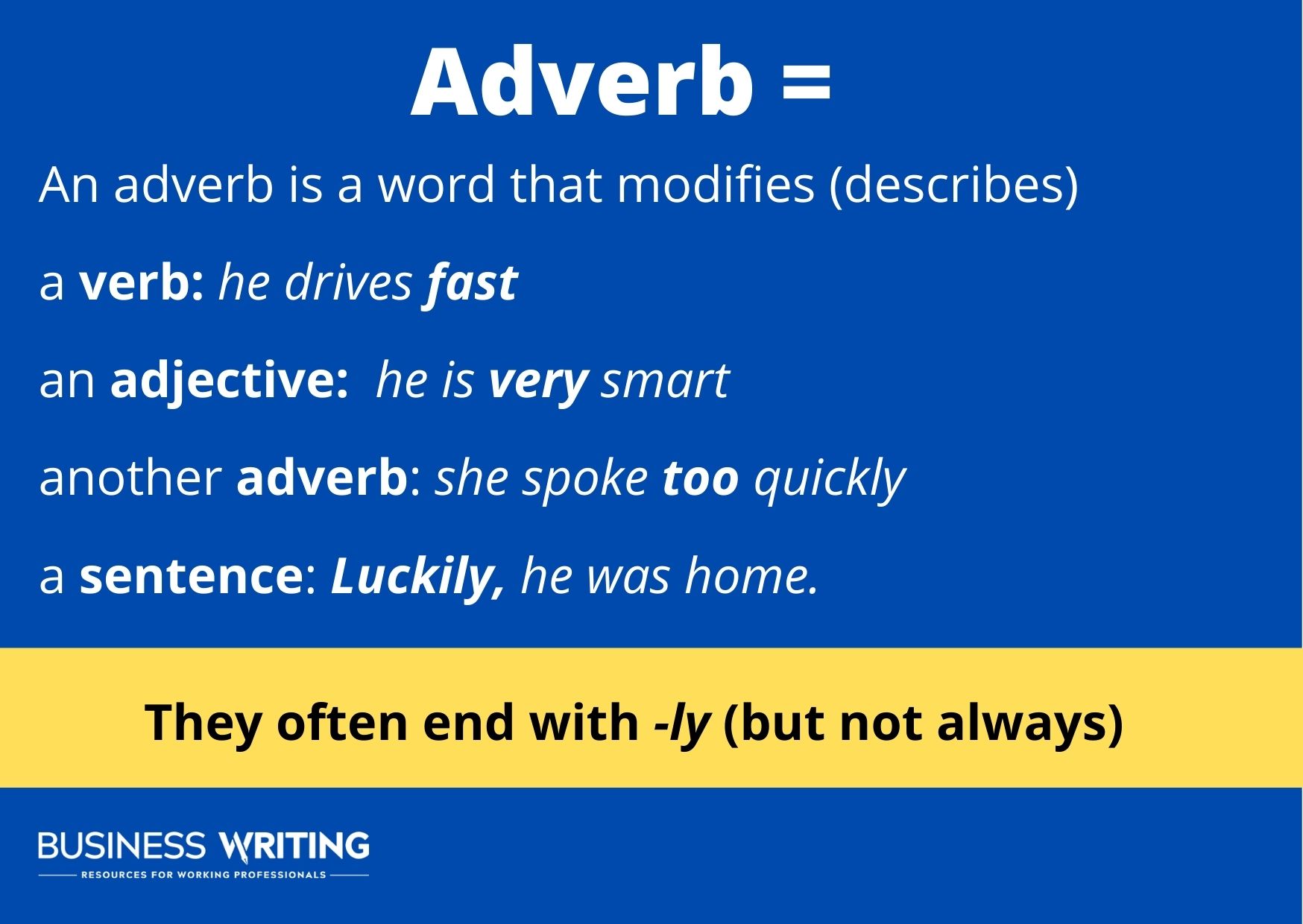
Types of Adverbs
Manner
An adverb of manner explains the way an action is carried out. Often, these are adjectives with -ly tagged on to the end; however, it certainly isn’t always the case. As a matter of fact, sometimes they will have the same spelling as the adjective form. For example:
1. Clumsily
2. Badly
3. Sadly
4. Loudly
5. Shyly
6. Diligently
7. Cautiously
8. Quickly
9. Sweetly
Here are some examples used in sentences:
- She passed to the next level easily.
- He walked quickly to board the plane.
- The presentation went poorly.
- Mary answered the question incorrectly.
As you can see, some adverbs are formed by simply adding -ly (bad, correct, quick) while others modify the spelling slightly (easy).
As we mentioned earlier, some adverbs of manner simply take the same spelling as their adjective counterparts and never add an -ly:
- The employees had worked hard.
- The car drives well.
Place
Adverbs of place, which are also referred to as spatial adverbs, describe where the action takes place. Essentially, they provide context for distance, position, and direction. For example: northwest, up, down, left, far away, front, outside, around. Usually, these do not end in -ly. Here are some examples:
Directions
- Boston is located north of New York
- They drove up the mountainside
- The searchers looked here and there but couldn’t find the wreck anywhere.
Often, here and there will be used at the beginning of a sentence in exclamation or to express emphasis.
- There you are!
- Here she is!
- There is something about her.
We can also see adverbs of place used as prepositions. The key difference is that when they are used as a preposition, they are followed by a noun, and when used as an adverb, they modify a verb.
- Boston is located north of New York -> Boston is on the map.
- They drove up the mountain -> They drove in a jeep.
- That dog was running around by itself-> He attached a chain around the dog’s neck.
Distance
- There was a McDonalds nearby
- The Joneses are moving far away.
- The cat is standing close to me.
Position
- The heating pipes lie underneath the floorboards.
- The man is sitting on the chair.
- Why is she standing in the middle of the doorway?
Some adverbs of position will precise a direction of movement, often ending in -wards or -ward:
- Jane drove onward to Los Angeles.
- Michael looked upwards to the night sky.
- Nick, move forward to the front of the line.
Frequency
These are used to express time or, as the title suggests, how frequently something happens. There are two main groups: adverbs of indefinite frequency and of definite frequency. The former have no clear meaning as to how often something happens: usually, normally, always. These are usually placed after the main verb or between the infinitive and the auxiliary verb. Here are some examples:
- I can normally run 10k in under 50 minutes.
- She will always love pancakes
- He usually walks home from work
The second kind – those of definite frequency, will usually be placed at the end of the sentence:
- They get paid weekly.
- She comes here daily
- The oil needs to be changed yearly.
- The newspaper is printed daily.
Time
These are seemingly similar to adverbs of frequency. They tell us when something occurs and are usually placed at the end of a sentence. Here are some examples:
- See you tomorrow!
- Michael forgot to bring in the report yesterday.
- She has to leave now.
- He bought his car last year.
Although adverbs of time usually belong at the end of the sentence, it is possible to start a sentence with them in order to put a different emphasis on the time.
- Last year was the most significant year of my life.
- Tomorrow our futures will be decided.
- Yesterday, all my troubles seemed so far away.
Purpose
Also known as adverbs of reason, these help to describe why something happened. They can be clauses, such as in order and so that, or they can be individual words – so, since, thus, because. Adverbs of purpose often connect sentences that otherwise would not make sense. Here are some examples:
- She started biking so that she wouldn’t be late to work.
- Because she was often late, she took up biking.
- Since it’s your first day, I will take you out to lunch.
Adverbs and verbs
Adverbs very often modify verbs. This means they describe the way an action is happening.
Example Phillip talks loudly in the class.
My dog waits impatiently for her food.
I will seriously consider your idea.
The adverbs in each of the above sentences all answer the question, in what manner? How does Phillip talk? Loudly. How does my dog wait? Impatiently. How will I consider your ideas? Seriously. Adverbs can answer other kinds of questions about how an action was performed. They will also tell you when (We arrived late) and where (Turn left).
There is one type of verb, however, that doesn’t mesh well with adverbs. Linking verbs, like feel, seem, smell, sound, and appear, commonly need adjectives, not adverbs. A very simple example of this type of mixup is
Incorrect I feel badly about what happened.
Because “feel” is a verb, it calls for an adverb rather than an adjective. But “feel” isn’t just any old verb; it is a linking verb. An adverb would describe how you act on feeling—an adjective describes something you feel. “I feel badly” means that you’re bad at feeling something. If you are trying to read Braille through thick leather gloves, then it would make sense for you to say, “I feel badly.” But if you are trying to say that you are experiencing some negative emotions, “I feel bad” is the phrase you want.
Adverbs & adjectives
Adverbs can also be utilized to modify adjectives or other adverbs. Often, their intent is to add a bit of intensity to the adjective.
Example The woman is quite beautiful.
This movie is more interesting than the last one.
The weather report is almost always right.
The adverb almost is modifying the adverb always, and they’re both modifying right.
Example “Is my singing too loud?” asked Phillip.
My cat is incredibly pleased to have his dinner.
We will be slightly early for our flight.
This prom dress is a very unflattering shade of blue.
Adverbs and other adverbs
You can use an adverb to describe other adverbs. And if you wanted to, you could use several.
Example Stephen talks rather enormously too loudly.
The problem is that it sometimes produces clunky and weak sentences like the one above, so be careful not to overuse them.
Adverbs and sentences
Some adverbs can modify an entire sentence—unsurprisingly, these are called sentence adverbs. Common ones generally include, fortunately, interestingly, and accordingly. Sentence adverbs do not describe one particular thing in the sentence—they describe a general feeling about all the information in the sentence.
Example Fortunately, we made it there in time.
Interestingly, no one at the auction seemed too interested in bidding on the antique spoon collection.
At one point in time, the use of the word hopefully as a sentence adverb (e.g., Hopefully, I will get this job) was condemned. People would continue to use it, though, and many style guides and dictionaries now accept it. However, there are still many readers out there who hate it, though, so it’s a good idea to stay away from using it in formal writing.
Levels of comparison
Like adjectives, adverbs can show levels of comparison, although it’s less common to use them this way. With certain “flat adverbs” (ones that look the same as their adjective counterparts), the comparative and superlative forms look the exact same as the adjective comparative and superlative forms. It’s normally better to use stronger adverbs (or stronger adjectives and verbs) instead of only relying on comparative and superlative adverbs.
Absolute adverbs describe something in its own right:
Example He smiled slyly.
A sloppily written letter.
To make a comparative form of an adverb that ends in -ly, add the word “more”-
Example He smiled more slyly than the others.
The more sloppily written letter contained the clue.
To make a superlative form of an adverb that ends in -ly, add the word “most”-
Example He smiled the most slyly of them all.
The most sloppily written letter on the desk was dismissed.
Placement of adverbs
Place adverbs as close as you can to the words they are supposed to modify. Placing the adverb in the wrong spot can produce an awkward sentence at best and totally change the meaning at worst. Be particularly careful about the word only, which is one of the most frequently misplaced modifiers. Consider the difference between these sentences:
Example Harry only fed the rabbit.
Harry fed only the rabbit.
The first sentence means that all Harry did was feed the rabbit. He didn’t pet the rabbit or pick it up or anything else. The second sentence implies that Harry fed the rabbit, but he didn’t feed the cat, the dog, or anyone else who might have been around.
When an adverb is modifying a verb phrase, the most natural place for it is usually the middle of the words.
Correct We are quickly approaching the deadline.
Phillip has always loved singing.
I will happily assist you.
When to avoid adverbs
Ernest Hemingway is often seen as an example of a great writer who detested adverbs and advised other writers to avoid them. In reality, it’s impossible to stay away from adverbs entirely. Sometimes we do need them, and all writers (even Hemingway) use them periodically. The secret is to avoid unnecessary adverbs. When your verb or adjective doesn’t seem strong or clear enough, instead of reaching for an adverb to add more color, try looking for a stronger adjective or verb instead. Most of the time, you will come up with a much better word, and your writing will be stronger for it.
Related: Learn about conjunctive adverbs here.
Quiz
Now test your newfound knowledge with this quick quiz:
1. My grandmother drives very slowly. The word “very” modifies
a. verb
b. adverb
c. noun
2. Your husband talks quite fast, doesn’t he? The word “quite” modifies
a. verb
b. adjective
c. adverb
3. We rarely go to out now that we have kids. The word “rarely” modifies
a. adverb
b. pronoun
c. verb
4. His backyard is practically a wild forrest. The word “practically” modifies
a. sentence
b. prepositional phrase
c. verb
5. Obviously, they could all be wrong. The word “obviously” modifies
a. verb
b. pronoun
c. clause
6. My daughter writes well for an eight-year old. The word “well” is
a. adjective
b. adverb
c. verb
7. My roommate drives a fast car. The word “fast” is
a. pronoun
b. adverb
c. adjective
8. I never shop for fruit at the supermarket store. The word “never” is
a. preposition
b. adverb
c. adjective
9. He drew a lovely sketch of his wife. The word “lovely” is
a. conjunction
b. adjective
c. verb
10. Everyone finds themselves feeling lonely from time to time. The word “lonely” is
a. adjective
b. adverb
c. conjunction
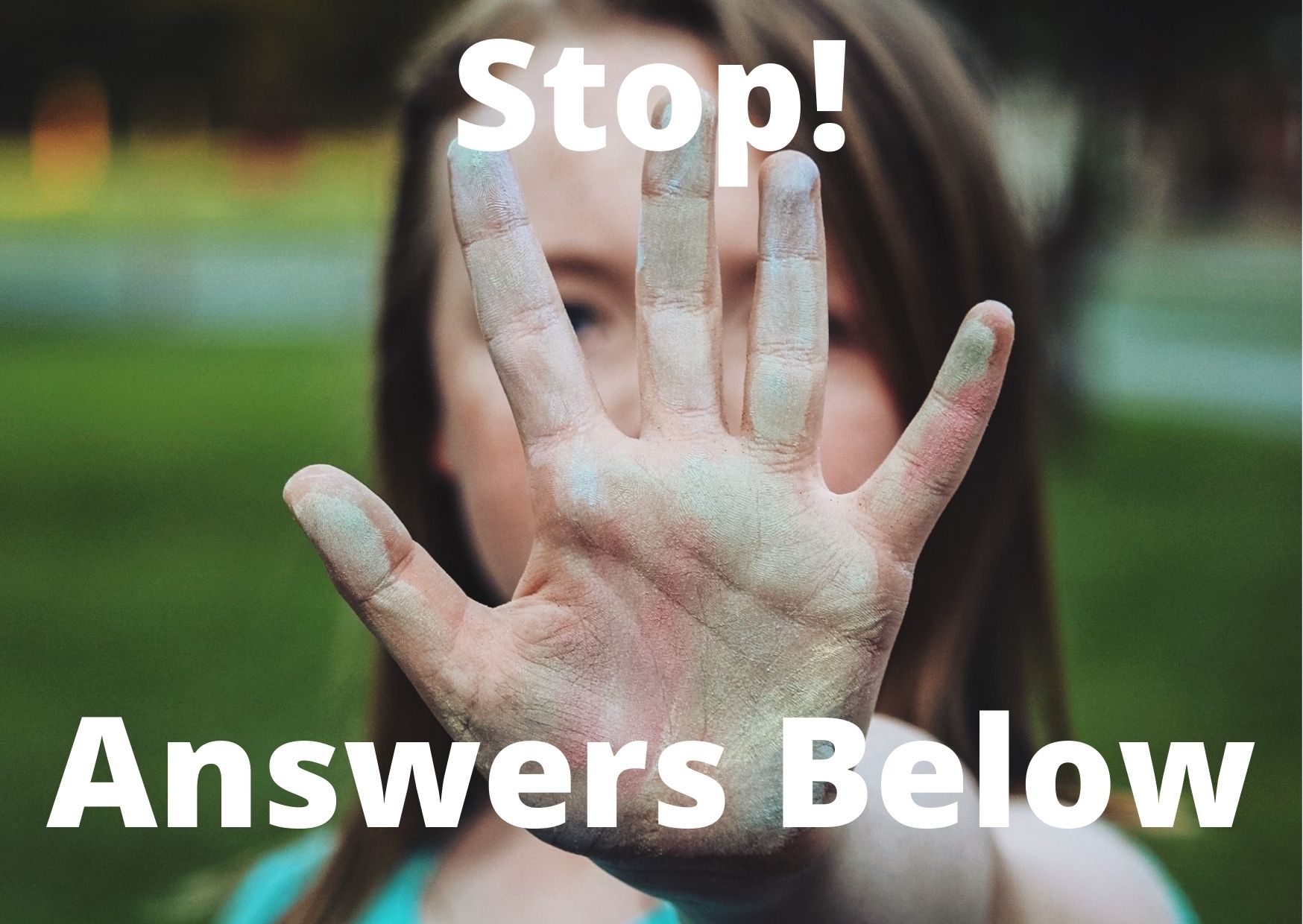
ANSWERS:
1. b
2. b
3. c
4. b
5. c
6. b
7. c
8. b
9. b
10. b
Want to sharpen your business writing skills? Discover our acclaimed online courses at syntaxtraining.com

